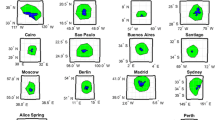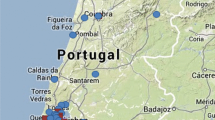Abstract
Long-term studies on urban phenology using network data are commonly limited by the small number of observation sites within city centres. Moreover, cities are often located on major rivers and consequently at lower altitudes than their rural surroundings. For these reasons, it is important (1) to go beyond a plain urban–rural comparison by taking the degree of urbanisation into account, and (2) to evaluate urbanisation and altitudinal effects simultaneously. Temporal phenological trends (1980–2009) for nine phenological spring events centred on the German cities of Frankfurt, Cologne and Munich were analysed. Trends of phenological onset dates were negative (i.e. earlier onset in phenology) for 96% of the 808 time series and significantly negative for 56% of the total number. Mean trends for the nine phenological events ranged between −0.23 days year−1 for beech and −0.50 days year−1 for hazel. The dependence of these trends and of mean dates on altitude and on the degree of urbanisation was explored. For mean dates, we demonstrated an earlier phenological onset at lower altitude and with a higher degree of urbanisation: altitude effects were highly significant and ranged between 1.34 days (100 m)−1 (beech) and 4.27 days (100 m)−1 (hazel). Coefficients for the log-transformed urban index were statistically significant for five events and varied greatly between events (coefficients from −1.74 for spruce to −5.08 for hazel). For trends in phenology, altitude was only significant for Norway maple, and no urban effects were significant. Hence, trends in phenology did not change significantly with higher altitudes or urbanised areas.


Similar content being viewed by others
References
Baumgartner A, Mayer H, Bründl W, Kotz A, Modlinger E, Noack EM (1984) Phänologische Beobachtungen in München. Bayerisches Staatsministerium für Landes- und Umweltfragen 8:30–35
Bernhofer C (1991) Stadtphänologie am Beispiel der Forsythia. Wetter Leben 43:213–218
Defia C, Clot B (2003) Long-term urban-rural comparison. In: Schwartz MD (ed) Phenology: an integrative environmental science. Kluwer, Dordrecht, pp 541–554
Defila C (1999) Der Einfluss des Stadtklimas auf die phänologischen Eintrittstermine. Schweiz Z Forstwes 150:151–153
Defila C, Clot B (2001) Phytophenological trends in Switzerland. Int J Biometeorol 45:203–207
Defila C, Clot B (2005) Phytophenological trends in the Swiss Alps, 1951–2002. Meteorol Z 14:191–196
Dittmar C, Elling W (2006) Phenological phases of common beech (Fagus sylvatica L.) and their dependence on region and altitude in southern Germany. Eur J For Res 125:181–188
European Environment Agency EEA (2000) CORINE Land Cover 2000. http://www.eea.europa.eu/themes/landuse/clc-download. Accessed 13 November 2009
Fitter AH, Fitter RSR (2002) Rapid changes in flowering time in British plants. Science 296:1689–1691
Franken E (1955) Der Beginn der Forsythienblüte 1955 in Hamburg. Ein Beitrag zur Phänologie der Großstadt. Meteorol Rundsch 8:113–114
Fukuoka Y, Matsumoto F (2008) The relationship between climate and plant phenology in Japanese cities. Proceedings of the 5th International Conference Urban Climate, Lodz Poland
Gazal R, White MA, Gillies R, Rodemaker E, Sparrow E, Gordon L (2008) GLOBE students, teachers, and scientists demonstrate variable differences between urban and rural leaf phenology. Glob Change Biol14:1568–1580
Guyon D, Guillot M, Vitasse Y, Cardot H, Hagolle O, Delzon S, Wigneron J-P (2010) Monitoring elevation variations in leaf phenology of deciduous broadleaf forests from SPOT/VEGETATION time-series. Remote Sens Environ. doi:10.1016/j.rse2010.10.006
Intergovernmental Panel on Climate Change (IPCC) (2007a) Climate Change 2007: Synthesis Report. Contribution of Working Group I, II and III to the Fourth Assessment Report of the Intergovernmental Panel on Climate Change (eds Core Writing Team, Pachauri RK, Reisinger A). IPCC
Intergovernmental Panel on Climate Change (IPCC) (2007b) Climate Change 2007: Impacts, Adaptions and Vulnerability. Contributions of Working Group II to the Fourth Assessment Report of the Intergovernmental Panel on Climate Change (eds Parry ML, Canziani OF, Palutikof JP, van der Linden PJ, Hanson CE). Cambridge University Press
Jarvis A, Reuter HI, Nelson A, Guevara E (2006) Hole-filled seamless SRTM data V3, International Centre for Tropical Agriculture, CIAT. http://srtm.csi.cgiar.org. Accessed 13 November 2009
Karsten M (1986) Eine Analyse der phänologischen Methode in der Stadtklimatologie am Beispiel der Kartierung Mannheims. Geographisches Institut, Universität Heidelberg
Koch E (1986) Auswirkungen der urbanen Wärmeinsel auf die Obstblüte. Arbor Phaenol 31:120–128
Kramer K (1995) Phenotypic plasticity of the phenology of seven European tree species in relation to climatic warming. Plant Cell Environ 18:93–104
Kuttler W (1998) Stadtklima. In: Sukopp H, Wittig R (eds) Stadtökologie. Ein Fachbuch für Studium und Praxis. Gustav Fischer, Stuttgart, pp 125–167
Lakatos L, Gulyás Á (2003) Connection between phenological phases and urban heat island in Debrecen and Szeged, Hungary. Acta Climatol Chorol 36–37:79–83
Landsberg HE (1981) The urban climate. Academic, New York
Larcher W (2006) Altitudinal variation in flowering time of lilac (Syringa vulgaris L.) in the Alps in relation to temperatures. Oesterr Akad Wiss Math-Naturwiss Kl Sitzungsber Abt I 212:3–18
Lu P, Yu Q, Liu J, Lee X (2006) Advance of tree-flowering dates in response to urban climate change. Agric For Meteorol 138:120–131
Luo Z, Sun OJ, Ge Q, Xu W, Zheng J (2007) Phenological responses of plants to climate change in an urban environment. Ecol Res 22:507–514
Matzarakis A (2001) Die thermische Komponente des Stadtklimas. Berichte des Meteorologischen Institutes der Universität Freiburg Nr. 6
Menzel A (1997) Phänologie von Waldbäumen unter sich ändernden Klimabedingungen – Auswertung der Beobachtungen in den Internationalen Phänologischen Gärten und Möglichkeiten der Modellierung von Phänodaten. Forstliche Forschungsberichte 164, München
Menzel A (2003) Phenological anomalies in Germany and their relation to air temperature and NAO. Clim Change 57:243–263
Menzel A, Estrella N, Fabian P (2001) Spatial and temporal variability of the phenological seasons in Germany from 1951 to 1996. Glob Change Biol 7:657–666
Menzel A, Sparks TH, Estrella N et al (2006) European phenological response to climate change matches the warming pattern. Glob Change Biol 12:1969–1976
Mimet A, Pellissier V, Quénol H, Aguejdad R, Dubreuil V, Rozé F (2009) Urbanisation induces early flowering: evidence from Platanus aceriflora and Prunus cerasus. Int J Biometeorol 53:287–298
Neil K, Wu J (2006) Effects of urbanization on plant flowering phenology: A review. Urban Ecosyst 9:243–257
Oke TR (1987) Boundary layer climates. Methuen, London
Parmesan C, Yohe G (2008) A globally coherent fingerprint of climate change impacts across natural systems. Nature 421:37–42
Pellissier V, Rozé F, Aguejdad R, Quénol H, Clergeau P (2008) Relationship between soil seed bank, vegetation and soil fertility along an urbanisation gradient. Appl Veg Sci 11:325–334
Root TL, Price JT, Hall KR, Schneider SH, Rosenzweig C, Pounds AJ (2008) Fingerprints of global warming on wild animals and plants. Nature 421:57–60
Rötzer T, Sachweh M (1995) Klimaänderungen im Spiegel phänologischer Zeitreihen. Arbor Phaenol 40:11–22
Rötzer T, Häckel H, Würländer R (1997) Agrar- und umweltklimatologischer Atlas von Bayern. Selbstverlag Deutscher Wetterdienst Weihenstephan, Weihenstephan
Rötzer T, Wittenzeller M, Häckel H, Nekovar J (2000) Phenology in central Europe – differences and trends of spring phenophases in urban and rural areas. Int J Biometeorol 44:60–66
Shustack DP, Rodewald AD, Waite TA (2009) Springtime in the city: exotic shrubs promote earlier greenup in urban forests. Biol Invasions 11:1357–1371
Sparks TH, Menzel A (2002) Observed changes in season: an overview. Int J Climatol 22:1715–1725
Stahel W (2008) Statistische Datenanalyse. Eine Einführung für Naturwissenschaftler. 5th edn. Friedr. Vieweg, Wiesbaden
Studer S, Appenzeller C, Defila C (2005) Inter-annual variability and decadal trends in Alpine spring phenology: a multivariate analysis approach. Clim Change 73:395–414
Tabachnick BG, Fidell LS (1989) Using multivariate statistics. HarperCollins, New York
Vitasse Y, Bresson CC, Kremer A, Michalet R, Delzon S (2010) Quantifying phenological plasticity to temperature in two temperate tree species. Funct Ecol 24:1211–1218
White MA, Nemani RR, Thornton PE, Running SW (2002) Satellite evidence of phenological differences between urbanised and rural areas of the eastern United States deciduous broadleaf forest. Ecosystems 5:260–277
Zacharias F (1972) Blühphaseneintritt an Straßenbäumen (insbesondere Tilia x euchlora KOCH) und Temperaturverteilung in Westberlin. Dissertation, Freie Universität Berlin
Zhang X, Friedl MA, Schaaf CB, Strahler AH, Schneider A (2004) The footprint of urban climates on vegetations phenology. Geophys Res Lett 31:L12209. doi:10.1029/2004GL020137
Ziello C, Estrella N, Kostova M, Koch E, Menzel A (2009) Influence of altitude on phenology of selected plant species in the Alpine region (1971–2000). Clim Res 39:227–234
Ziska LH, Gebhard DE, Frenz DA, Faulkner S, Singer BD, Straka JG (2003) Cities as harbingers of climate change: Common ragweed, urbanization, and public health. Allergy Clin Immunol 111:290–295
Acknowledgements
We thank the German Meteorological Service for permission to use their phenological data. The research conducted in this study was supported by the grant ME 179/3-1 of the Deutsche Forschungsgemeinschaft (DFG).
Author information
Authors and Affiliations
Corresponding author
Rights and permissions
About this article
Cite this article
Jochner, S.C., Sparks, T.H., Estrella, N. et al. The influence of altitude and urbanisation on trends and mean dates in phenology (1980–2009). Int J Biometeorol 56, 387–394 (2012). https://doi.org/10.1007/s00484-011-0444-3
Received:
Revised:
Accepted:
Published:
Issue Date:
DOI: https://doi.org/10.1007/s00484-011-0444-3




